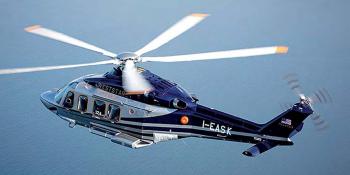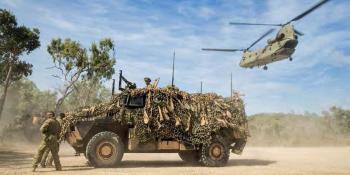Nigel Pittaway reviews the history and development of Japan’s X-2 ShinShin fighter demonstrator
MILITARY MITSUBISHI X-2

Japan became just the fourth country to join the world’s stealth fighter club in April 2016, with the first flight of its X-2 technology demonstration aircraft.
Although not intended to be placed into production, the JPY 39 billion Mitsubishi Heavy Industries (MHI) X-2 is nevertheless an integrated design intended to inform Japan’s future F-3 fighter programme, which may result in an indigenous design, rather than buying off the shelf from the United States or other western fighter manufacturers.
The F-3 programme is intended to replace the Japan Air Self Defense Force’s (JASDF) fleet of Mitsubishi F-2 fighters with a new type around the end of the next decade and Japan essentially has three options. First, it could purchase a foreign fifth-generation (or sixth) fighter, as it recently did with the Lockheed Martin F-35A, which is replacing the JASDFs F-4EJ Phantom fleet under the F-X programme. Second, it could develop a new fighter indigenously, using the X-2 as the springboard for its local industry. Third, it could partner a western manufacturer to develop a new fighter using its experience gained with the X-2.
Japan is facing increasing threat from an aggressive China, which is developing its own fifth-generation fighters and has a land attack capability with cruise missiles. Together with the escalating possibility of war on the Korean Peninsula, this has recently seen the government of Prime Minister Shinzo Abe begin steps to strengthen the country’s defence forces and to position Japanese industry for potential export of arms and equipment.
Japan’s Liberal Democratic Party/Komeito coalition under the leadership of Abe won a landslide victory in the country’s elections in October 2017, adding further weight to the argument for local fighter development.
X-2 described
Formerly known as the Advanced Technology Demonstrator – Experimental (ATD-X) the X-2 is, as its name suggests, a technology demonstrator designed to stimulate the technological evolution of Japan’s defence industry in preparation for an indigenous fighter, which may be selected to replace the F-2 fleet around 2030.
The X-2 is designed to explore the development of an air superiority fighter, with stealth characteristics and the ability to manoeuvre in the post-stall regime. It will also research the application of advanced technologies and systems integration, which Japanese reports suggest will make the F-3 a sixth-generation fighter aircraft.
Mitsubishi is the manufacturer of the X-2 airframe and is the prime contractor to the Japanese government for the programme. The aircraft is known locally as the ShinShin (variously translated as ‘Mind and Body’ and ‘Heart of God’) and the programme began in 2009, when MHI and Japanese engine manufacturer Ishikawajima-Harima Heavy Industries (IHI) were tasked by the Japanese government’s Acquisition, Technology and Logistics Agency (ATLA) to develop the ATD-X.
IHI is responsible for the development of the X-2’s twin XF5-1 afterburning turbofan engines, which have a three-stage, lowpressure compressor and single-stage LP turbine, together with a six-stage, high-pressure compressor and single HP turbine. The engines installed on the first (and so far, only) X-2 prototype have thrust-vectoring paddles incorporated into the exhaust nozzle.
Thrust is reportedly in the region of 11,000lb in dry thrust and the engine is also being used to develop technologies for what IHI refers to as the Next Generation Hyper Slim Engine for the F-3 programme.
The general configuration of the X-2 airframe itself is reminiscent of the Lockheed Martin F-22 Raptor, with widely spaced canted fins and engine intakes, provision for an internal weapons bay and a chined forward fuselage.
With a length of 14.2m (46ft 6in) and a wingspan of 9.1m (29ft 8in), the X-2 is smaller than either the Raptor or the likely F-3 aircraft and it also has a large canopy, with an equipment bay behind the single pilot’s seat.
The design incorporates stealth technology, using composite, radarabsorbing materials and careful shaping, similar to current fifth-generation designs and it has a fibre-optic flight control system. Around 220 Japanese defence companies are involved in the manufacture of the X-2, including Fuji Heavy Industries, which manufactured the wings and empennage and Kawasaki Heavy Industries, which was responsible for the forward fuselage and cockpit section.
Ube Industries is responsible for the radar-absorbing materials and NEC and Toshiba supply much of the avionics, sensors and communications systems.
Japan is also developing an active electronically scanned array (AESA) radar for the programme, which local reports suggest will be superior to other fifthgeneration fighters, with the use of more advanced semiconductors and improved heat-resistant materials. A fact often overlooked is that Japan was the first nation to introduce an AESA-equipped fighter to service in 1995, with the Mitsubishi J/APG-1 radar fitted to the F-2. This radar has since been upgraded to J/APG-2 configuration and Mitsubishi is leading the development of the future radar for the F-3.
Development
Japan had previously been interested in the F-22 for its F-X programme, but US government restrictions on the export of the air superiority fighter ultimately resulted in the purchase of 42 F-35A Lighting IIs instead.
The Raptor’s uncompromising approach to air dominance was reportedly the trigger for Japan to begin development of an air superiority fighter of its own, in time for the F-2 replacement at the end of the next decade. Aside from AESA radar technology, however, local industry would need to be upskilled in advance, and this in turn was the reason behind the ATDX/ X-2.
As noted earlier, development of what would eventually become the X-2 began in 2009, and on March 28, 2012, MHI reported that it had begun assembly of a full-scale structural testing model of the aircraft, under contract to Japan’s Ministry of Defence.
At the Tobishima Plant of MHI’s Nagoya Aerospace Systems Works, in the Aichi Prefecture, the first rivet was ceremonially driven into a bulkhead that separates the fuel tank from the forward equipment bay in the mid-fuselage structure of the structural test article on that date, marking the beginning of the production phase of the programme.
After the ceremony, MHI noted: “The ATD prototype project was launched in the Japanese Fiscal Year 2009 in response to next-generation fighter development programmes in neighbouring countries.
Through flight tests of advanced technologies relating to stealth and high manoeuvrability, the project aims at the empirical research of advanced fighter technologies and air defence systems that are capable of coping with the stealth fighters that may soon be deployed around Japan.”
At the time, the company said the programme was on track to produce a flight test model that would make its initial flight during 2014, with project completion set for the end of March 2017.
The first images of the new aircraft were released to Japanese media in August 2014, but few technical details were provided at that time. Resplendent in red and white markings, the first prototype (51-0001/001) was formally rolled out in a ceremony at the MHI plant at Komaki, adjacent to Nagoya airport in the Aichi Prefecture, on January 28, 2016. At the time, Japan’s Ministry of Defence revealed the aircraft was planned to make its first flight from Nagoya in mid- February.
The two-year programme delay has been reported by Japanese sources to be the result of “a number of issues”, including engine control software development.
Initial flight
In the event, the first flight did not occur until April 22, 2016, when 51-0001 lifted off from Nagoya’s runway at 08:47hrs local time and landed at the nearby JASDF Gifu Air Base just 26 minutes later, at 09:13hrs.
The X-2 was put through a series of tests during the short flight, including basic flight manoeuvres, climbs and descents. After landing, MHI said that the unnamed test pilot had reported the aircraft to be “extremely stable” in flight and declared the event a success.
The pilot, somewhat predictably, was reported to have said: “Control of the aircraft went exactly as in our simulator training sessions, and after piloting the aircraft I’m 100% positive the X-2 is magnificent and will meet the Ministry of Defence’s requirements.”
After the completion of the initial flight, Japan’s Defence Minister, Gen Nakatani, told reporters: “The maiden flight was significant to secure the necessary capability for a next-generation fighter jet. We can expect technological innovation in the aerospace industry, as well as application of that technology in different fields.”
Following its initial flight test period with the company, the single X-2 was initially due to be delivered to the JASDF for further testing in March 2017, but in November 2016, Japan’s Defence Ministry indicated that it would conduct initial field testing on the aircraft beginning the same month.


Japanese media reported that the campaign would focus on the evaluation of the X-2’s stealth qualities and that testing would continue until the end of the 2016 financial year. In Japan, the financial year runs from April 1 to March 31 and therefore the campaign was due to conclude in March 2017.
A decision on whether to proceed with an indigenous fighter programme is anticipated at the end of the 2018 financial year (i.e. by March 31, 2019). At that time, a decision is also expected to be made on whether Japan will develop the new fighter alone or engage with one or more international partners. If the go-ahead is given for an indigenous fighter programme, the new aircraft is planned to enter serial production in 2027.
Future decisions
One important decision will be whether the cost of an indigenous Japanese fighter programme can be somewhat offset by export sales. It will be up to the government to decide whether it will allow the aspiredto sixth-generation technology to be exported in the first instance, but if so, the new rules for arms exports introduced by the Abe government in 2014 will make this process easier to achieve.
In June 2016, the Japanese Ministry of Defence released a request for information to western fighter manufacturers, regarding the possibility of forming partnerships with local industry to pursue a replacement fighter for the 84 surviving Mitsubishi F-2 aircraft.
Lockheed Martin already has a close relationship with Japan’s defence industry (and in particular with MHI) through the F-2 programme, which used the F-16C Fighting Falcon as the reference design and, more recently, via the establishment of a F-35A Final Assembly and Check Out (FACO) facility at Nagoya. The FACO is operated by MHI with technical assistance from Lockheed Martin and US government oversight and is completing 38 of the 42 F-35As on order for the JASDF.
Boeing is also reported to have shown interest in partnering local industry in Japan and has also recently been pushing an upgrade programme for the JASDF’s Mitsubishi-built F-15J Eagle fleet.
More recently, Japan’s Ministry of Defence announced that the UK Ministry of Defence signed an agreement in Tokyo with the ATLA in Tokyo in March this year. The agreement covers the sharing of advanced aircraft design information between the two countries, with an option to explore the possibility of co-development of a new fighter.
Given that there isn’t a current fighter design that meets the JASDF’s requirements for a future air superiority fighter and, even with export sales, developing a homegrown fighter is an extremely expensive exercise, it would therefore appear that a partnership between a western fighter manufacturer and Japanese industry is the most likely outcome.
In much the same way that BAE Systems’ (then British Aerospace) Experimental Aircraft Programme of the 1980s developed a single prototype, which spurned the international Eurofighter Typhoon, Japan’s X-2 ShinShin could possibly be the forerunner of a sixth-generation fighter that also sees service with air forces other than the JASDF.






